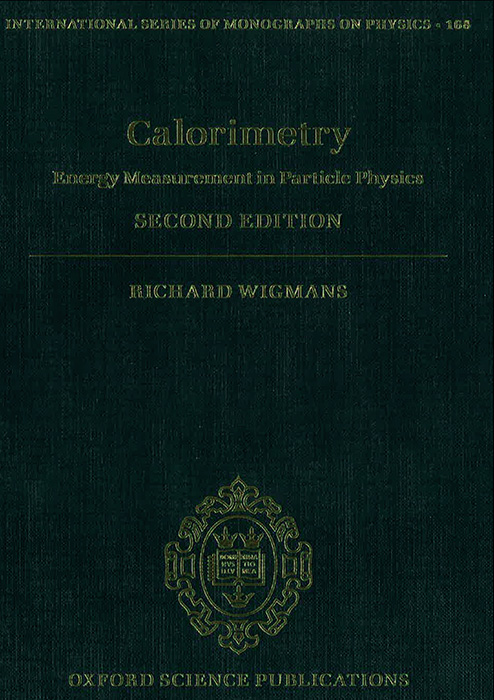By Richard Wigmans
Oxford Science Publications

When the first edition of this book appeared in 2000, it established itself as “the bible of calorimetry” – not only because of the exhaustive approach to this subtle area of detection, but also because its author enjoyed worldwide recognition within the field. Wigmans gained it thanks to his ground-breaking work on the quantitative understanding of so-called compensating calorimeters (i.e. how to equalise the response of such detectors for electromagnetic and hadronic interactions) and to the leading role he played in designing and operating large detectors that are still considered to be state of the art.
As with the real Bible, which underwent several revisions, this book has been reviewed in depth and published in a second edition. The author has updated it to take into account the last 16 years of progress in the field and to improve its impact as a reference for both students and practitioners.
At first look, one immediately notices that considerable work has been put into improving the quality of the graphics and figures – introducing colours where appropriate – and this new edition is available as an e-book. But there is much more to this updated version.
Chapters two to six, in which the fundamentals of calorimetry are discussed, follow the same thorough structure of the first edition, but they include new insights and use more recent data for illustration, mostly coming from the LHC experiments. Chapters one (Seventy Years of Calorimetry), seven (Performance of Calorimeter Systems) and 11 (Contributions of Calorimetry to the Advancement of Science) have also been brought up to date. Chapters eight, nine and (to a large extent) 10 are brand new and, in my opinion, represent the real added value of this new edition. In particular, chapter eight (New Calorimeter Techniques) discusses the two most relevant innovations introduced in the field during the past decade: dual-readout calorimetry (DRC) and particle-flow analysis (PFA).
The concept of DRC is elaborated upon to circumvent the limitations of compensating hadron calorimeters. Their performances depend crucially on the detection of the abundant contribution of the neutrons produced in the hadronic shower development, which in turn requires the use of heavy absorbers and a small sampling fraction – with the consequent loss of resolution for electromagnetic showers – as well as a relatively large signal-integration time and volume. In DRCs, signals coming from scintillation and Cherenkov processes provide complementary information about the shower development and allow the measurement of the electromagnetic fraction of hadron showers event by event, thus eliminating the effects of fluctuations on calorimeter performance. This concept is discussed in depth and predictions are compared with R&D results on prototypes, providing a convincing experimental demonstration of this novel technique. Although no full-scale calorimeter of this type has been built so far, the results obtained with real detectors, combined with Monte Carlo simulations, have outlined the breakthrough power of this idea, which has all the potential to rival the performances of the best compensating calorimeters, with much better energy resolution for electromagnetic showers. It is very stimulating food for thought for whoever is poised to design next-generation calorimeters.
The other important topic discussed in chapter eight, PFA, is a completely different method that is being used to improve calorimeter performances for jets. It is based on the combined use of a precision tracker and a high-granularity calorimeter, which measures the momentum of charged-jet particles and the energy of neutral particles, respectively. High granularity is mandatory to avoid double counting of the charged particles already measured by the tracker. The topic is treated in great detail, with abundant examples of the application of this technique in real experiments, and its pros and cons are discussed in view of future large-scale detector systems.
As an example, the idea that one can relax the requirements on the calorimeters, since they measure on average only one third of the particles in a jet while the remaining two thirds are very well measured by the tracker, is strongly questioned because the jet-energy resolution would be dominated by the fluctuations in the fraction of the total jet energy that is carried by the charged fragments.
Chapter nine (Analysis and Interpretation of Test Beam Data) is a brand-new addition that I find extremely illuminating and will be valuable for more than just newcomers to the field. By going through it, I have retraced the path of some of my mistakes when dealing with calorimeters, which are complex and subtly deceptive detectors, often exhibiting counterintuitive properties.
Finally, chapter 10 (Calorimeters for Measuring Natural Phenomena) is a tribute to the realisation and successful employment of calorimetric systems to the study of natural phenomena (neutrinos, cosmic rays) in the Antarctica, the Mediterranean Sea and the Argentinian pampa, inside a variety of mountains and deep mines, and in space.
In summary, this second edition of Calorimetry fully meets the ambitious goals of its author: it is a well written and pleasant book, a reference manual for both beginners and experts, and a source of inspiration for future developments in the field.







